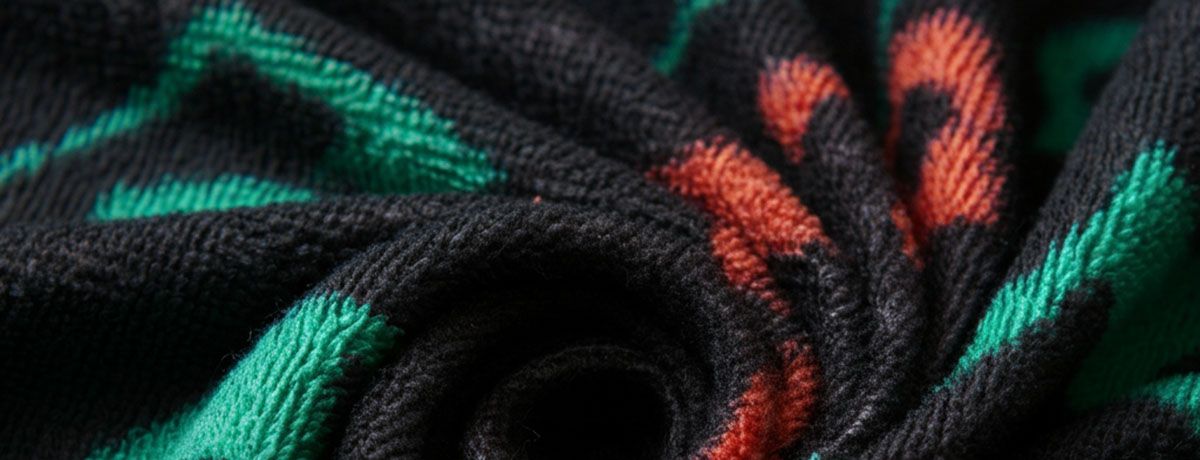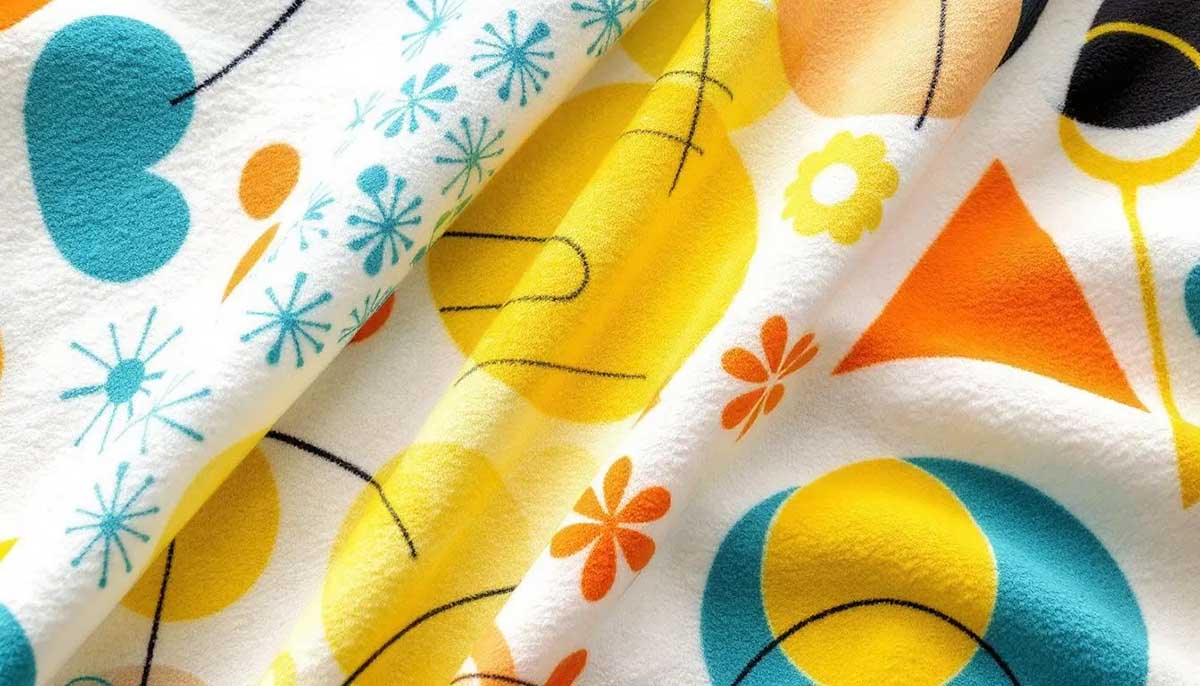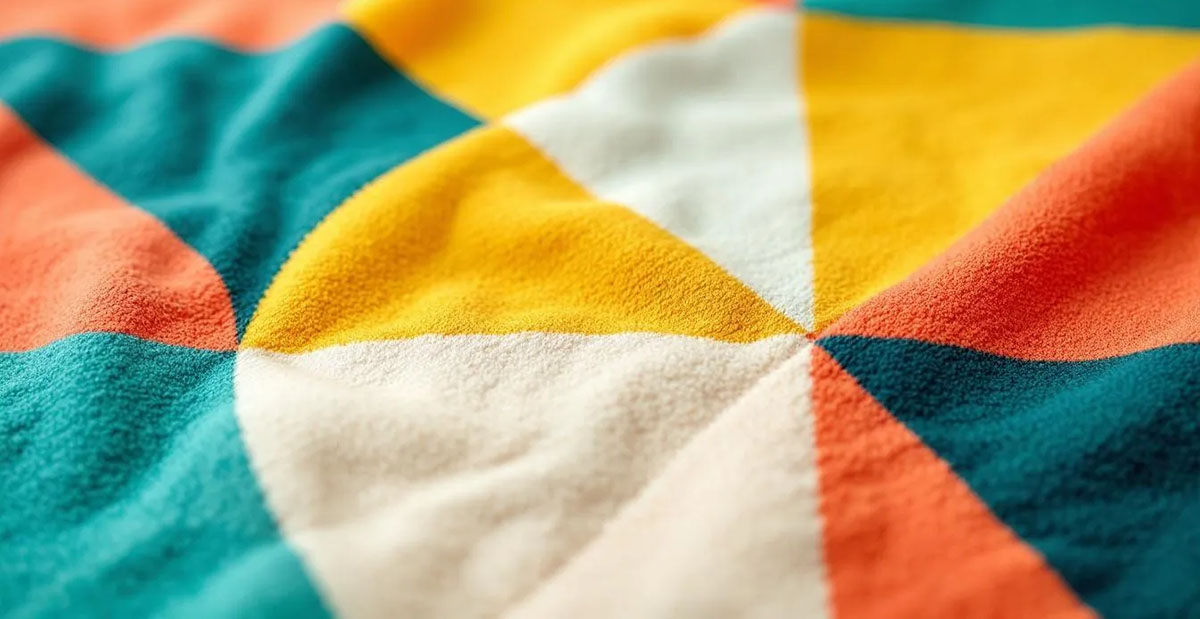Best Print Terry Cloth Fabric for Your Custom Projects

Interested in printing on print terry cloth fabric? This article will guide you through the best methods to achieve vibrant, durable designs on this unique material. Learn about print resolutions, fabric care, and how to maintain print quality.
Key Takeaways
-
Terry cloth fabric is known for its absorbency and unique texture, making it suitable for various products like towels and robes, and offers a luxurious feel when printed.
-
Achieving high-quality prints on terry cloth requires optimal print resolution, appropriate color models, and careful consideration of image scaling to maintain clarity and vibrancy.
-
Eco-friendly printing practices, along with managing material shrinkage and understanding color variances, are essential for producing sustainable and high-quality custom terry cloth products.
Introduction to Terry Cloth Fabric
Terry cloth fabric is renowned for its plush softness and exceptional absorbency, making it a staple for products like towels, robes, and comfortable clothing. Characterized by its looped surface on one side and a smooth finish on the other, terry cloth fabric stands out for its ability to soak up moisture while remaining gentle against the skin. This unique structure not only enhances its functionality but also makes it a versatile choice for custom fabric printing projects.
When considering fabric printing on terry cloth, it’s important to understand the various fabric printing processes available. The quality and file weight of your design play a crucial role in achieving sharp, vibrant results. For those looking to create custom prints, terry cloth fabric works well with sublimation transfer paper, allowing for detailed and durable designs. Whether you’re aiming for bold patterns or subtle graphics, selecting the right printing method and preparing your design files properly will ensure your finished product meets your expectations.
Types of Terry Cloth Fabric
Terry cloth fabric comes in several varieties, each offering distinct benefits for different applications. Cotton terry is a classic favorite, prized for its natural fibers, breathability, and reliable absorbency—making it ideal for bath towels and spa robes. Bamboo terry, on the other hand, is celebrated for its eco-friendly qualities and ultra-soft texture, providing a sustainable option for those seeking a gentle touch. Microfiber terry, a synthetic alternative, excels in quick drying and wrinkle resistance, making it perfect for sports towels and travel accessories.
When selecting a terry cloth fabric for your project, consider the specific qualities you need, such as absorbency, softness, and durability. Many fabric printing processes are compatible with terry cloth, including digital printing and the use of print sublimation transfer paper. These methods allow you to digitally print intricate designs or vibrant patterns directly onto the fabric, ensuring your custom creations are both functional and visually appealing. Cotton terry, in particular, responds well to a variety of printing techniques, making it a versatile choice for many custom projects.
Printing on Terry Cloth Fabric

Terry cloth fabric is a technical and beautiful material, making it suitable for a variety of towel and robe products. Printed terry toweling allows for bold colors with great contrast, enhancing visual appeal. For certain fabrics, including terry cloth, slight variations in cut or finish may occur due to their unique properties; this is normal for handmade textile work and does not indicate a quality issue. When printed, terry fabric features a slightly ribbed surface which adds to its unique texture.
Due to its exceptional absorbency, terry cloth is ideal for custom products such as beach towels, robes, and washcloths. Terry cloth bathrobes provide a plush texture and warmth, offering a spa-like experience at home.
Surface Texture and Print Quality

The combination of cotton terry and microfiber creates a luxurious texture that enhances the overall feel of the fabric. This blend ensures that printed designs on french terry cloth fabric are bold and rich, with excellent detail and stunning colors. However, dark or dense colors may be more prone to fading after repeated washing or heavy use, so extra care should be taken when selecting and maintaining these shades.
The cotton terry loop back provides additional absorbent properties, making the fabric ideal for various applications. The microfiber face ensures a bold and rich print on terry cloth fabric.
Optimal Print Resolution
Achieving a high-quality print on terry cloth fabric relies heavily on the optimal print resolution. For the best results, a recommended print resolution of 200dpi should be maintained. This ensures that the prints are clear, detailed, and vibrant, capturing the essence of your design perfectly.
Working with print providers ensures that image resolution remains intact throughout the printing process. Users can also check the quality of their uploaded image in the design interface where the quality marker changes color and provides a message about print methods.
Image Scaling and Dimensions
Image scaling and dimensions are key to maintaining print quality on fabric. The system automatically scales uploaded designs to fit the chosen fabric dimensions, ensuring that your design is accurately represented. This is essential for achieving a good quality image that maintains its clarity and detail across the fabric while considering quality and file weight.
Users can check and edit image dimensions in the ‘Images & Text Tools’ section to verify an image’s resolution. The preview design window allows users to visualize their fabric prints up to a certain length, such as 10 yards, before ordering, while the preview design window set helps manage print dimensions and pattern visualization. Ensuring the correct image scale and print size is vital for producing prints that look professional and crisp.
Choosing the Right Color Model: RGB vs. CMYK
The RGB color model helps achieve vibrant colors in printed designs on terry cloth. Unlike CMYK, which is often used for print, RGB is better suited for digital screens and is increasingly preferred for fabric printing. Choosing the RGB color space as the working color space in your editing software yields the best results.
The sRGB profile is recommended for optimal color reproduction when printing on terry cloth fabric. This color space is recognized for its consistency across various devices, making it ideal for digital images intended for printing. Using sRGB can help minimize color discrepancies in printed fabrics, ensuring colors appear as intended.
Maximum Print Dimensions
The maximum print dimensions for terry cloth fabric are determined by the fabric printing processes and the chosen fabric dimensions. The length of the fabric ordered is not restricted, allowing for unlimited orders. There is no strict print limit on the length of fabric you can order; the fabric order process is designed to accommodate custom lengths and finishing options.
Simply increase the quantity to order greater lengths of fabric (e.g., x2 for 20 yds, x4 for 40 yds, etc.).
You can find the maximum print width for each fabric on the individual fabric pages. It is also available in the design interface. An automatic volume discount is applied for larger fabric orders, making it more cost-effective to print in bulk.
Incorporating White Space for Borders
Adding extra space for borders accommodates cutting and trimming requirements. Approximately 0.2 inches of white space should be added to ensure a clean and professional finish. This helps incorporate white space to prevent any important design elements from being cut off during the fabric cutting process.
Understanding Crocking and How to Prevent It
Crocking occurs when dyes or pigments rub off onto other surfaces due to abrasion, impacting both natural and synthetic fibers. Preventing crocking requires high-quality dyes that bond tightly to fabric fibers.
Fabrics that are loosely woven are more susceptible to crocking because their fibers are more prone to friction. Using a cool hand wash instead of machine washing can also help minimize crocking. Finishing processes, such as applying a resin, can help seal the dye within the fabric and minimize crocking with light woven fabrics. Using poly fabric can also help prevent crocking and improve the durability of printed designs.
Color Differences on Organic vs. Non-Organic Fabrics
Colors appear lighter on organic fabrics due to lower ink absorbs, which can reduce color strength by about 40%. Non-organic natural fabrics are recommended for stronger color strength when printing. Non organic natural fabric tends to produce more vivid, intense colors due to their coatings or treatment methods. Each fabric, including light fabrics, fabric prints, and other light fabrics, has unique attributes such as thickness and opacity, which influence how colors appear when printed.
Lighting conditions can also affect the perceived color differences in printed fabrics. Knowing these factors aids in selecting the right fabric for custom projects, ensuring accurate color representation.
Handling Customer-Supplied Fabric
Printing is not offered on fabric that customer supplies, in order to maintain quality control and consistency in the final products.
For customers who want to use their own fabrics, print sublimation transfer paper can be printed to order, provided they have access to a heat press. This allows for some level of customization while ensuring quality control.
File Formats for Design Submission
The right file format is key to successful print results. JPEG files are acceptable for simpler designs and low detail files imagery. TIFF format is recommended for detailed designs to ensure high-quality prints.
Flattening layers in a TIFF file before saving ensures the print reflects the design as intended. This helps in maintaining the integrity of the design during the printing process.
Managing Material Shrinkage
When printing on terry cloth fabric:
-
The expected material shrinkage remains within the 2-8% range.
-
Customers should order extra fabric to account for this shrinkage.
-
It is recommended that clients order additional fabric to accommodate the expected shrinkage of 2-8%.
Prewashing fabric manages shrinkage and ensures the final product maintains its dimensions. Proper planning and ordering can prevent issues related to material shrinkage. Due to the handmade nature of the process, achieving a perfectly straight cut is not always possible, and slight variations in the edges are normal.
Single-Sided Printing Limitations
Double-sided printing is limited on terry cloth due to the transparency of the fabric, which affects print quality. Transparency issues arise when printing on the reverse side of terry cloth, resulting in a less desirable visual effect.
The printing process on terry cloth only accommodates single-sided applications to maintain design integrity. Single-sided printing is preferred to avoid bleed-through and ensure vibrant colors and clear designs.
Custom Labels Options
Currently, custom labels are solely made from the same satin fabric. Normal fabric labels are available as a standard option, but currently only in satin fabric. There are no options for custom fabric types other than satin for labels. This ensures that the labels are of high quality and consistent with the overall product standards.
Eco-Friendly Fabric Printing Practices
Eco-friendly fabric printing practices are essential for reducing environmental impact and promoting sustainability. Using completely water based inks, which are biodegradable and free from harsh solvents, ensures a healthier printing environment. The printing process avoids chemicals, including solvents, contributing to cleaner production methods. All the printing is handled in one dedicated facility using eco-friendly practices from ink application to final production and fulfillment. Additionally, fabric printing eco friendly practices help in achieving these goals.
On-demand production, like Digital Direct-to-Garment printing, reduces waste by only creating what is necessary, complemented by folded packaging to minimize material waste. The heat fixing process avoids generating excess or contaminated water, further reducing environmental impact.
Special care is taken when handling and packaging delicate fabrics to ensure they arrive in perfect condition.
Slight Color Variations Between Orders
Slight color differences may occur due to improvements in color profiles and fabric variations, including those involving black or white thread. Such color variations are usually minor and do not create a fairly significant difference in the overall quality of the printed fabric. These variations are a normal part of working with delicate, natural textiles and do not indicate a quality issue.
Hemming and Shrinkage Considerations
Hemming is a crucial finishing technique that impacts the overall quality and aesthetics of the finished product, including hemming material allowances. A zigzag stitch maintains fabric elasticity and provides a durable hem. A hemmed edge is created by folding and sewing the fabric to prevent fraying and produce a clean, polished border.
Incorporating stay tape can stabilize hems and reduce shifting during sewing. Customers can request one hemmed edge or multiple hemmed edges depending on their finishing preferences.
Prewashing the fabric can prevent future shrinkage and ensure that hems remain intact. Prints hemmed with specific thread colors and fold types can be customized to match your project needs. Measuring and marking the hemline accurately is crucial for achieving a precise finish.
A professional sew service is available to ensure precise hemming and finishing for your custom fabric prints.
Finishing Options for Edges
Four finishing options are available for custom printed terry cloth fabric, which can be achieved through many fabric printing processes. The manual cutting process may cause a slightly uneven look on the edges of the fabric, but this does not affect the quality. Customers can press their own fabrics easily using a heat press and sublimation transfer paper for at-home finishing.
Edges may be uneven or fraying due to the handmade nature of fabric cuts; this is not considered a flaw. Expecting edge imperfections during the handmade cutting process helps manage expectations. Special care is taken when finishing other light woven fabrics, such as silk or chiffon, to minimize fraying and maintain a clean edge.
Water Absorbency of Terry Cloth Fabric

The looped design of terry cloth enhances its absorbency, making it ideal for bath and beach towels. Terry cloth’s absorbent properties are enhanced by its cotton composition, which provides softness and moisture-wicking capability.
In sports, terry cloth is used for gym towels and wristbands because of its ability to quickly absorb sweat. Due to its construction, terry cloth is capable of holding moisture efficiently, making it suitable for high-traffic items like bathrobes and sportswear.
Crease Resistance and Maintenance
Terry cloth fabric doesn’t crease much, making it ideal for use in various custom projects. Maintaining terry cloth fabric involves washing, hang drying, ironing, and steaming safely.
Key features and care instructions for the fabric include:
-
Minimal material shrinkage of less than 2% during washing, allowing for manageable maintenance.
-
Printed terry cloth fabric is bleach cleanable with a weak bleach solution not exceeding 1% concentration.
-
This ensures the fabric’s appearance is preserved during maintenance.
Minimum Order Requirements
There is no minimum order requirement for printing on terry cloth fabric. It is recommended to order a standard size of 40” x 20” for optimal printing outcomes.
Small fabric samples are available for customers to test the quality and suitability of the fabric before placing a larger order. Ordering the recommended purchased fabric size of 40” x 20” ensures optimal printing results.
Ordering and Production Process
Ordering custom printed terry cloth fabric is a straightforward process designed to give you creative control and high-quality results. Start by selecting from a range of pre-made designs or uploading your own artwork. The design interface features a quality marker that uses a traffic light system to help you assess the resolution and suitability of your image for fabric printing. This ensures your design meets the necessary quality and file weight requirements for optimal print clarity.
Once your design is finalized, the printing process uses completely water-based inks, which are both vibrant and environmentally friendly. A specialized heat fixing procedure sets the colors and prints without the need for steaming, preserving the integrity of your design. After printing, the fabric cutting is performed manually, so slight variations or minor fraying along the edges are normal and add to the handmade character of your order. You can choose from several finishing options, such as hemming or sewing, to complete your project.
It’s important to account for material shrinkage, which can range from 2% to 8% depending on the fabric type. Incorporate white space into your design to allow for borders or cutting space, ensuring no important elements are lost during production. The maximum print width for each fabric is clearly listed on individual fabric pages and within the design interface, making it easy to plan your project. For larger orders, automatic volume discounts are available, making it cost-effective to print in bulk while supporting fabric printing eco-friendly practices that minimize waste and environmental impact.
Contact MH
MH offer terry fabrics, feel free to reach out to us for more details or inquiries. We're here to help!


